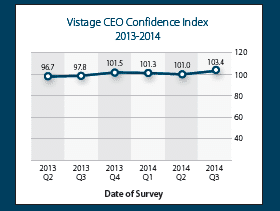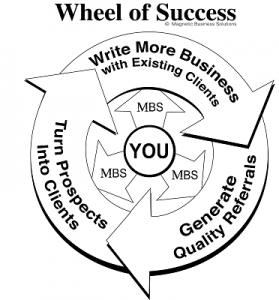Vistage CEO Confidence Index
Optimism at a Two Year High among Small and Mid-sized CEOs, According to New Survey from Vistage
SAN DIEGO (October 1, 2014) – Optimism among small and mid-sized business leaders is at a reported two year high, according to the Vistage CEO Confidence Index, the largest survey of chief executives from small and medium-sized businesses in the United States. And this vote of confidence from these business leaders reveals a positive trend in the U.S. economy as a whole.
The Voice of Main Street Business
History
The
Vistage CEO Confidence Index is a compilation of responses from more
than 2,000 CEOs of small- to mid-sized companies. The Vistage CEO
Confidence Index began in Q1 2003 and is the largest and only
comprehensive report of small and mid-size CEO opinions and projections.U.S. small and mid-sized businesses represent the most vital component of the nation’s economy. This sector creates 75% of all new jobs and generates 50% of all national revenue. The opinions of these business leaders provide a clear snapshot of current economic, market and industry trends and demonstrate their plans for growth over the next 12 months. These insights provide a leading indicator for employment, capital expenditure, sales, and revenue and profit trends.
When It Began
The
Vistage CEO Confidence Index began in Q2 2003 when 1041 Vistage member
CEOs responded to a Vistage survey, creating the baseline against which
the index is measured. Since then, the Index has grown into the largest
survey of chief executives from small and medium-sized businesses in the
United States. Each quarter, CEOs are asked the same set of 9 questions
based on the overall economy, as well as 5-7 questions relating to
current economic issues. The set questions become the components of the
Confidence Index score.
How is the Confidence Index Calculated?
All
component questions are scored as the percent giving favorable replies
minus the percent unfavorable plus 100. The Vistage Confidence Index is
the sum of the components calculated as a percentage of the level
recorded in the 2nd quarter 2003 survey. The results are analyzed by Dr.
Richard Curtin, the chief analyst at the University of Michigan, Ann
Arbor.
About Dr. Curtin
 Dr.
Richard Curtin is a Research Professor and the Director of the Surveys
of Consumers at the University of Michigan since 1976.
Dr.
Richard Curtin is a Research Professor and the Director of the Surveys
of Consumers at the University of Michigan since 1976.Professor Curtin’s monthly report on consumer confidence is one of the most closely followed economic indicators, with findings from his research extensively reported in the media. His research is widely used by businesses and financial institutions as well as by federal agencies responsible for monetary and fiscal policies. Data from the Surveys of Consumers is an official component of the Index of Leading Economic Indicators.
Through frequent presentations and published articles, Professor Curtin has reported on his research in behavioral economics, including the theory and measurement of expectations, consumer saving and spending behavior, household income and wealth, reactions to changing economic opportunities, and public policy preferences. Professor Curtin has consulted with hundreds of corporations on issues related to future trends in consumer purchases.
Archives
- Q3 2014 Summary
Q3 2014 Infographic - Q2 2014 Summary
Q2 2014 Infographic - Q1 2014 Summary
Q1 2014 Infographic - Q4 2013 Summary
Q4 2013 Infographic - Q3 2013 Summary
- Q2 2013 Summary
Q2 2013 Infographic - Q1 2013 Summary
Q1 2013 Infographic - Q4 2012 Summary
Q4 2012 Infographic - Q3 2012 Summary
Q3 2012 Infographic - Q2 2012 Summary
Q2 2012 Infographic - Q1 2012 Summary
Q1 2012 Infographic - Q4 2011 Summary
Q4 2011 Infographic - Q3 2011 Summary
Q3 2011 Infographic - Q2 2011 Summary
- Q1 2011 Summary
- Q4 2010 Summary
- Q3 2010 Summary
- Q2 2010 Summary
- Q1 2010 Summary
- Q3 2009 Summary
- Q2 2009 Summary















